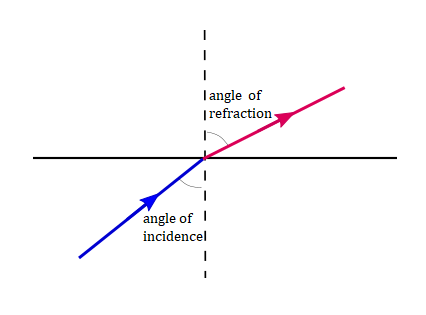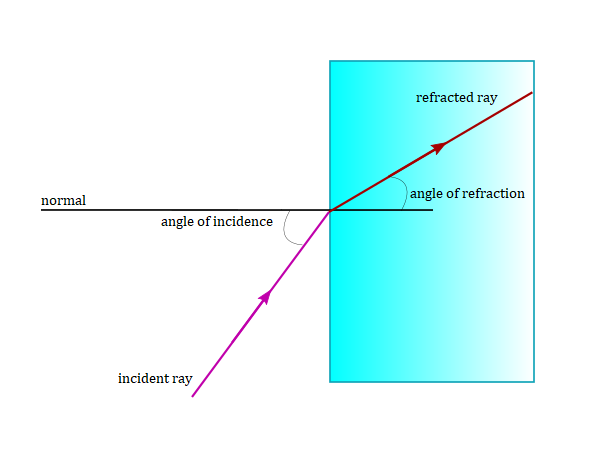
All Solutions
Page 542: Review

And the larger its value is the slower the speed of light in other medium will be, therefore that medium will refract ray more and the one which will refract it the most is the one with index of $2.30$.
First, light enters medium which is more dense and refracts and disperses into seven different colours.
After, when it reaches the other end of the droplet, part of it internally reflects and the other part is being refracted while entering the medium with less dens, air.
Part of light that has been internally reflected can be observed.

$textit{c.}$, Angle of refraction could never reach $90^{o}$ since, when entering an optically denser medium from the one with less dense, it always bends towards the normal.
Angle of refraction will always be smaller than the angle of incidence.
$textit{c.}$, No, it can never reach $90^{o}$.
$textit{b.}$, The higher is the value of index of refraction of a medium, the slower the speed of light in that medium will be, therefore, speed of light will be slower in medium A.
$textit{c.}$, Since we can get all the important information by knowing the angle of refraction and angle of incidence, direction of light is not important since the angles will not change because of the direction.
$textit{b.}$, Light will be slower in medium A.
$textit{b.}$, Direction is irrelevant in this case.
$textit{b.}$, Prisms are used more than mirrors since the silver coating on the mirrors can diminish over time, but with prisms, there will not be such a problem, also prisms reflect all the light that falls on them by the internal reflection, and part of the light which is falling on the mirror can be absorbed.
$textit{b.}$, Prisms are used most since the silver coating on mirror can diminish over the time which is not case with prisms which are made of completely of glass and incident ray is being completely reflected while falling on them and in the case of mirror it can be partially absorbed.
It is an optical, and since there is no real object it is a virtual image.
$$
c=3times10^8
$$
$$
v=1.84times10^8
$$
$$
n=dfrac{c}{v}
$$
Substitute values:
$$
n=dfrac{3times10^8}{1.84times10^8}
$$
Simplify and evaluate:
$$
n=dfrac{3}{1.84}=1.6304
$$
$$
c=3times10^8
$$
$$
v=1.47times10^8
$$
$$
n=dfrac{c}{v}
$$
Substitute values:
$$
n=dfrac{3times10^8}{1.47times10^8}
$$
Simplify and evaluate:
$$
n=dfrac{3}{1.47}=2.0408
$$
$$
c=3times10^8
$$
$$
v=2.1times10^8
$$
$$
n=dfrac{c}{v}
$$
Substitute values:
$$
n=dfrac{3times10^8}{2.1times10^8}
$$
Simplify and evaluate:
$$
n=dfrac{3}{2.1}=1.429
$$
$$
c=3times10^8
$$
$$
n=1.47
$$
$$
n=dfrac{c}{v}
$$
Solve for $v$:
$$
v=dfrac{c}{n}
$$
Substitute values:
$$
v=dfrac{3times10^8}{1.47}
$$
Simplify and evaluate:
$$
v=2.0408times10^8
$$
$$
c=3times10^8
$$
$$
n=1.65
$$
$$
n=dfrac{c}{v}
$$
Solve for $v$:
$$
v=dfrac{c}{n}
$$
Substitute values:
$$
v=dfrac{3times10^8}{1.65}
$$
Simplify and evaluate:
$$
v=1.bar8bar1times10^8
$$
$$
c=3times10^8
$$
$$
n=1.92
$$
$$
n=dfrac{c}{v}
$$
Solve for $v$:
$$
v=dfrac{c}{n}
$$
Substitute values:
$$
v=dfrac{3times10^8}{1.92}
$$
Simplify and evaluate:
$$
v=1.5625times10^8
$$
$textit{b.}$, Signals which are being transmitted over the copper wires are in the form of current.
There will be loss of the signals during the resistance of copper wires which is not case in fibre-optic cables where signal is transmitted completely.
$textit{b.}$, There is loss in signal because of the resistance that copper gives and there is no loss when it comes to optical-fibre cables.
Therefore, brother should dive at an angle which will show the right position of the puck under the water.
Knowledge of refraction has helped my in understanding certain atmospheric phenomenon such as formation of rainbow, since it is one of the main processes during which it is being formed.
It has enhanced the way I look at events such as shimmering, formation of mirages and rainbows.
It occurs when cooler, dense layer of air underlies the heated layer and vice versa, therefore, since the ray of light is travelling through the layers of air which have different optical density, it is being bent due to the speed changing which causes the refraction.
It is formed when the ray of light enters a droplet of rain, and since it enters a medium with different optical density, it will be bent. Along with the refraction there is a diffusion during which the beam of light is being separated into different colours because of the different changes in speeds of each one while entering a new medium.
Also, there is a internal reflection when it strikes the exit surface of the droplet, and the other part which is not being reflected internally, escapes the droplet and the rainbow is being formed.
It’s value is: $c = 299792458, mathrm{m/s}$
He sent his assistant who has been carrying a lit up lantern which has been covered with a bucket, to a far mound and he has been carrying a lantern covered with bucket himself.
Later, Galileo has lifted the bucket, and the light has been travelling towards the assistant which had to lift up his bucket at the moment he sees the light from Galileo’s lantern and Galileo has been measuring the time.
Of course, he did not succeed to measure it precisely and to determine the speed of light, therefore, his experiment has failed.
He has been repeating these measurements on a daily basis and after a long research he concluded that period of rotation of the satellite Io is shorter when the Earth is closer to the Jupiter, and vice versa.
Therefore, it has been clear that light takes time to travel this distance.
He has calculated in which time light travels distance which equals length of the radius of the Earth’s orbit which is $22, mathrm{min}$.
At the beginning of the 20. century, he has performed the most famous measuring of speed of sound in history.
He has been using rotating mirror with six angles and many sides which causes the diffusion of the beam of light.
At each side of the mirror has been placed one plane mirror, and the whole system has been rotating thanks to the electromotor.
Value that he has measured is $c = 299792458, mathrm{m/s}$ and he got the Nobel prize for this experiment.
As the ray of light enters a new medium, which is a water droplet, during the refraction it is being bent and diffused into different colours. When it gets to the exit surface of the droplet, part is being internally reflected an d part exits the droplet and the rainbow is formed.
Wen we drive at the daylight, back surface of the mirror reflects light and images and when we change the orientation of the mirror glass, by flipping the switch, front surface will reflect light and images.
Since the light and images now have to travel through the back side before they hit the front side and bounce back to us, lights behind us will be perfectly reduced.

